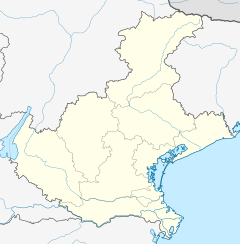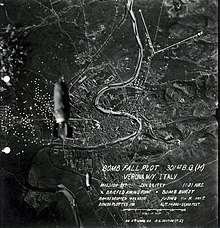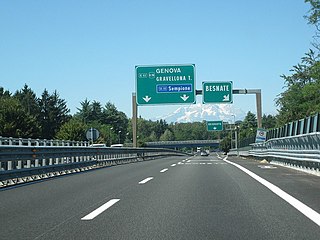
Italy has a well developed transport infrastructure. The Italian rail network is extensive, especially in the north, and it includes a high-speed rail network that joins the major cities of Italy from Naples through northern cities such as Milan and Turin. The Florence–Rome high-speed railway was the first high-speed line opened in Europe when more than half of it opened in 1977. Italy has 2,507 people and 12.46 km2 per kilometer of rail track, giving Italy the world's 13th largest rail network. The Italian rail network is operated by state-owned Ferrovie dello Stato, while the rail tracks and infrastructure are managed by Rete Ferroviaria Italiana.

Milano Centrale is the main railway station of the city of Milan, Italy, and is the second railway station in Italy for passenger flow and the largest railway station in Europe by volume.
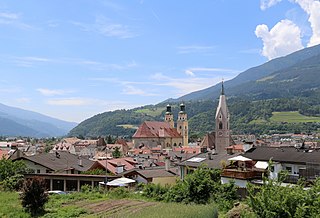
Brixen is a town and commune in South Tyrol, northern Italy, located about 40 kilometres (25 mi) north of Bolzano.

Bologna Centrale is the main railway station in Bologna, Italy. The station is situated at the northern edge of the city centre. It is located at the southern end of the Milan-Bologna high-speed line, which opened on 13 December 2008, and the northern end of three lines between Bologna and Florence: the original Bologna-Florence line through Porretta Terme and Pistoia; the Bologna–Florence Direttissima via Prato, which opened on 22 April 1934 and the Bologna-Florence high-speed line, which opened to traffic on 13 December 2009.
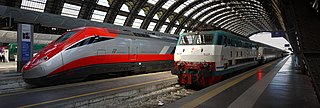
The Italian railway system is one of the most important parts of the infrastructure of Italy, with a total length of 24,227 km (15,054 mi) of which active lines are 16,723 km (10,391 mi). The network has recently grown with the construction of the new high-speed rail network. Italy is a member of the International Union of Railways (UIC). The UIC Country Code for Italy is 83.

Venezia Santa Lucia is the central station of Venice in the north-east of Italy. It is a terminus and located at the northern edge of Venice's historic city . The station is one of Venice's two most important railway stations; the other one is Venezia Mestre, a mainline junction station on Venice's mainland district of Mestre. Both Santa-Lucia and Mestre stations are managed by Grandi Stazioni and they are connected to each other by Ponte della Libertà.

Most railway stations in Italy are maintained and operated by RFI, a subsidiary of Ferrovie dello Stato Group. A minor part of them are operated by private and regional companies, conceded by the state.

The Verona–Bologna railway is a major Italian railway connecting Verona and Bologna and part of the major axis from the Brenner railway to the Bologna–Florence and on to Rome. The line is part of the Line 1 of Trans-European Transport Networks (TEN-T). It is considered a "fundamental" line by the state railways Ferrovie dello Stato (FS).

The Brenner Railway is a major line connecting the Austrian and Italian railways from Innsbruck to Verona, climbing up the Wipptal, passing over the Brenner Pass, descending down the Eisacktal to Bolzano/Bozen, then further down the Adige Valley to Rovereto/Rofreit, and along the section of the Adige Valley, called in Italian the “Vallagarina”, to Verona. This railway line is part of the Line 1 of Trans-European Transport Networks (TEN-T). It is considered a "fundamental" line by the state railways Ferrovie dello Stato (FS).

Pordenone railway station serves the city and comune of Pordenone, in the autonomous region of Friuli Venezia Giulia, northeastern Italy. Opened in 1855, the station is located on the Venice–Udine railway. Although it is not a junction or terminal station, it is used by a great many passengers.

Vicenza railway station serves the town and comune of Vicenza, in the Veneto region, northeastern Italy. Opened in 1846, it forms part of the Milan–Venice railway, and is also a junction of two branch lines, to Schio and Treviso, respectively.

Bolzano/Bozen railway station is the main station of Bolzano/Bozen, capital of the autonomous province of Alto Adige/Südtirol, in northeastern Italy.

Trento railway station is the main station of Trento, capital of the autonomous province of Trentino, in northeastern Italy.

Rovereto railway station serves the Comune of Rovereto in the autonomous province of Trentino, northeastern Italy.
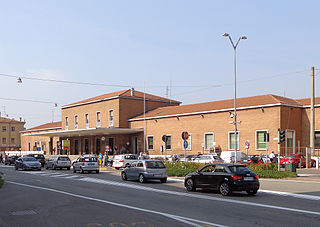
Mantua Railway Station is the main station of Comune of Mantua in the Region of Lombardy, northern Italy.

Desenzano del Garda-Sirmione railway station serves the town and comune of Desenzano del Garda, in the region of Lombardy, northern Italy. Opened in 1854, it forms part of the Milan–Venice railway.

Brenner railway station is the border station of Italy and Austria. It serves the town and comune of Brenner in the autonomous province of South Tyrol, northeastern Italy.

Peschiera del Garda railway station serves the town and comune of Peschiera del Garda, in the region of Veneto, northern Italy. Opened in 1854, it forms part of the Milan–Venice railway.

The Trento–Venice railway is an Italian state-owned railway line connecting Trento, in Trentino-Alto Adige, to Mestre, a suburb of Venice, in the Veneto region. At Mestre, it connects to the main line from Verona.

Mirandola railway station is a railway stop along the Verona-Bologna railway serving the city of Mirandola, in the province of Modena, in Emilia-Romagna, Italy. The station serves also the municipalities of Medolla, Cavezzo, San Possidonio, and Finale Emilia. Located in the village of Cividale, about 3 km from the town centre of Mirandola, th station is connected by a SETA shuttle bus.

